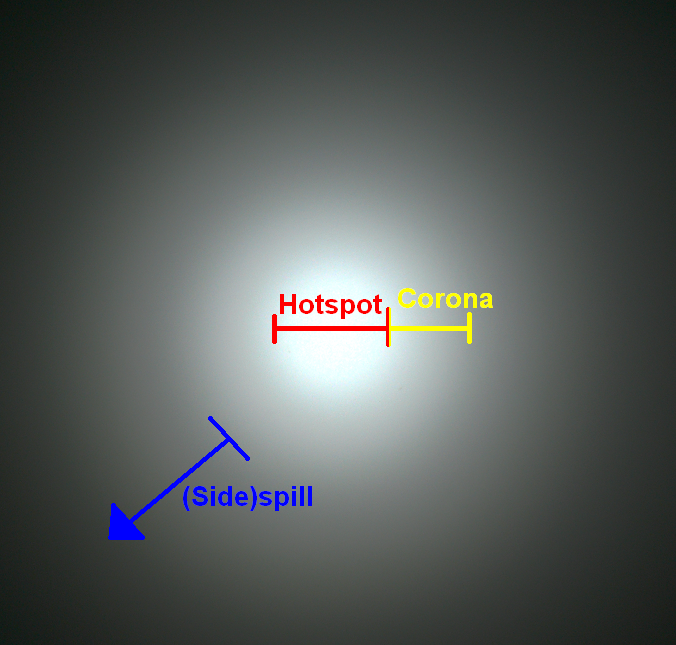Beam Anatomy
by TigerhawkT3
The first terms you should know when discussing beams are "throw," "flood," and "artifact."
-Throw is a flashlight's ability to project light over a distance. In flashlights with a lens, parabolic reflector, or other optical system attempting to get parallel rays of light, a beam with higher point brightness in the center will throw better than others. Remember that this isn't universal: For example, a flashlight with an ellipsoidal reflector would create a very tight, bright spot at a certain distance away (the ellipse's other focus), but almost no beam at all at other distances.
-Flood describes a light's ability to illuminate a large area, especially at close distances. It's especially useful for when you're indoors or working with something in your immediate surroundings. Some flashlights "focus" (get it? Focus? ![]() ) entirely on flood, such as lights with little or no reflector and lanterns. These are very useful for general illumination during power outages or on camping trips, but their lack of distance lighting capability makes them less popular than throwers.
) entirely on flood, such as lights with little or no reflector and lanterns. These are very useful for general illumination during power outages or on camping trips, but their lack of distance lighting capability makes them less popular than throwers.
-An artifact in a flashlight's beam refers to a flaw or imperfection that interrupts the beam's geometric shape. The beam from a traditional incandescent Maglite or Minimag is chock-full of artifacts, as the reflectors are smooth and project a more or less direct image of the filament, producing strange shapes. Artifacts can be decreased or even eliminated by using stippled reflectors or diffusing filters. Spill describes the light that did not hit a flashlight's reflector and so is not part of the bright central spot. The angle of this spill can be up to 90 degrees or more, which is actually quite useful for illuminating the objects surrounding the well-lit point of interest. Some flashlights, such as those with lenses and especially aspheric lenses, produce little or no spill, creating a light with lots of throw but poor flood capability.
Furthermore, there are several components to a classic flashlight's beam. The following image, video and description are for a flashlight with a power LED or incandescent bulb and a parabolic reflector. The image is a beamshot of a Scorpion LED modded with a Seoul P4 USW0I.

The hotspot is the brightest, central area in the beam. It is the portion of the beam that provides throw. If you were to illuminate someone's face with the hotspot (not recommended) and they were to look directly at it (not recommended), they would see the reflector's entire surface area illuminated (assuming an ideal, artifact-free hotspot). If they are being illuminated by the flashlight but not by the hotspot, they will see the light source plus a partially illuminated reflector, with the illumination level being determined by how close to the target the hotspot is.
Surrounding the hotspot is the corona. It is less intense than the hospot, but more intense than the light surrounding it. It is important to note that many flashlights do not have a corona to speak of. These lights are usually optimized for throw, as the more light that falls into the corona, the less available for the hotspot. However, the corona is an excellent attribute for a general use (indoor, navigation, etc.) light, as it provides a wider area of illumination around the hotspot while being brighter and more useful than the surrounding light, known as sidespill.
Sidespill, or spill, is the very wide, dim circle of light between the rest of the beam and the surrounding darkness. This is the light that is going directly from the light source to the target without hitting the reflector. A person whose face was illuminated by spill (not recommended, but not as bad as the hotspot) would actually see the light source, but the reflector would be reflecting very little light toward them. Spill allows people to use a "throwy" flashlight for general purpose tasks, as, although most of the beam would be in the hotspot and possibly the corona, there would be a generous wash of light over a wide area.
Lights that use TIR optics or aspherics have different beams altogether. TIR lights have a hotspot and possibly a corona, but no sidespill. Aspherics create only a hotspot, with the tightest and best-throwing spot achieved when the light source (usually a Cree XR-E) is at the lens's focal point. The lack of spill in these lights significantly reduces their popularity, with aspherics being especially optimized for throw and little else.
Lanterns are even more unique. They produce a wide flood, either in a 180- or 360-degree pattern, and artifacts are very undesirable. Lanterns that simply use bare emitters are technically all spill, but the intense emitters can be uncomfortable to even glance at. Many lanterns employ some sort of integral diffuser to soften the light as well as reduce artifacts.